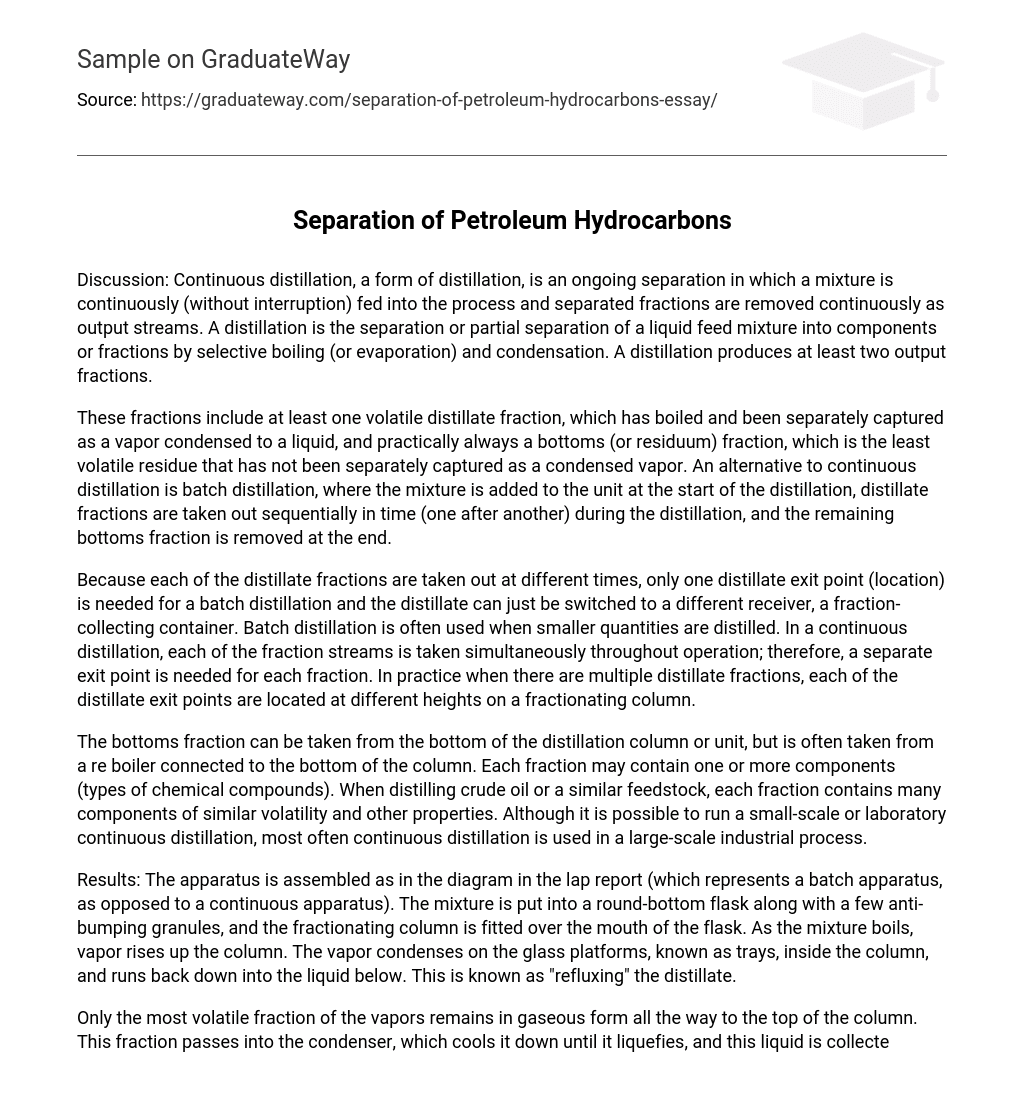Discussion: Continuous distillation, a form of distillation, is an ongoing separation in which a mixture is continuously (without interruption) fed into the process and separated fractions are removed continuously as output streams. A distillation is the separation or partial separation of a liquid feed mixture into components or fractions by selective boiling (or evaporation) and condensation. A distillation produces at least two output fractions.
These fractions include at least one volatile distillate fraction, which has boiled and been separately captured as a vapor condensed to a liquid, and practically always a bottoms (or residuum) fraction, which is the least volatile residue that has not been separately captured as a condensed vapor. An alternative to continuous distillation is batch distillation, where the mixture is added to the unit at the start of the distillation, distillate fractions are taken out sequentially in time (one after another) during the distillation, and the remaining bottoms fraction is removed at the end.
Because each of the distillate fractions are taken out at different times, only one distillate exit point (location) is needed for a batch distillation and the distillate can just be switched to a different receiver, a fraction-collecting container. Batch distillation is often used when smaller quantities are distilled. In a continuous distillation, each of the fraction streams is taken simultaneously throughout operation; therefore, a separate exit point is needed for each fraction. In practice when there are multiple distillate fractions, each of the distillate exit points are located at different heights on a fractionating column.
The bottoms fraction can be taken from the bottom of the distillation column or unit, but is often taken from a re boiler connected to the bottom of the column. Each fraction may contain one or more components (types of chemical compounds). When distilling crude oil or a similar feedstock, each fraction contains many components of similar volatility and other properties. Although it is possible to run a small-scale or laboratory continuous distillation, most often continuous distillation is used in a large-scale industrial process.
Results: The apparatus is assembled as in the diagram in the lap report (which represents a batch apparatus, as opposed to a continuous apparatus). The mixture is put into a round-bottom flask along with a few anti-bumping granules, and the fractionating column is fitted over the mouth of the flask. As the mixture boils, vapor rises up the column. The vapor condenses on the glass platforms, known as trays, inside the column, and runs back down into the liquid below. This is known as “refluxing” the distillate.
Only the most volatile fraction of the vapors remains in gaseous form all the way to the top of the column. This fraction passes into the condenser, which cools it down until it liquefies, and this liquid is collected in the receiving flask. The efficiency in terms of the amount of heating and time required to get fractionation can be improved by insulating the outside of the column with an insulator such as wool, aluminum foil, or (preferably) a vacuum jacket. The hottest tray is at the bottom and the coolest is at the top. At steady state conditions, the vapor and liquid on each tray are at equilibrium.
The fractionation is more thorough with the addition of more trays (up to certain practical limitations). In laboratory distillation, any of several types of condensers may be used. The Liebig condenser is simply a straight tube within a water jacket, and is the simplest (and relatively least expensive) form of condenser. The Graham condenser is a spiral tube within a water jacket. The Allihn condenser has a series of large and small constrictions on the inside tube, each increasing the surface area upon which the vapor constituents may condense.
In alternate set-ups, a “cow” or “pig” adapter may be used, connected to three or four receiving flasks. By turning the “cow” or “pig,” the distillates can be channeled into the appropriate receiver. A Perkin triangle may also be used to collect distillation fractions, without requiring a “cow” or “pig” adapter. A Perkin triangle is most often used when the distillates are air-sensitive, or when the fractions distill and are collected under reduced pressure, but it can be used for simple as well as fractional distillations.
Vacuum distillation systems operate at reduced pressure, thereby lowering the boiling point of the materials. Conclusions: 1. Simple distillation is not enough to completely separate two liquid mixtures. If a mixture of two liquids is distilled, the distillate is sure to contain a majority of one liquid and a small percentage of the second liquid. To separate the distillate of the liquids, further re-distillation is required. The number of re-distillations required depends on the liquids that are to be distilled.
Fractional distillation comes into use at this stage. 2. Fractional distillation uses an apparatus called the fractionating column, which separates the liquids completely. For this purpose, the mixture is boiled, and when it turns to vapor, it rises up the fractionating column. The vapor condenses after it reaches a certain point in the column. Then, it again turns to vapor and rises up the column. This process continues till the vapor reaches the top of the column and finally condenses in the condenser. This is the point when you get completely purified liquid. 3.
One of the primary applications of fractional distillation is the refining of crude oil. Crude oil consists of a complex mixture of hydrocarbons and, hence, its separation has to be done with care. Fractional distillation is used for distillation of crude oil containing only a small amount of volatile fractions in it. 4. The main advantage of using fractional distillation for the separation of crude oil is that only a small plant is required for the operation, thus reducing the operating costs. Thus, fractional distillation plays a major role in the process of refining of petroleum.





